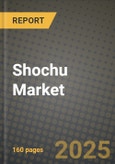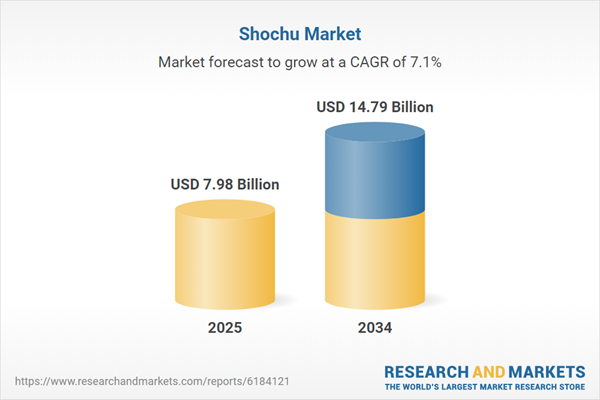Shochu Market
The Shochu market spans traditional honkaku (single-distilled, pot still) expressions and korui (multi-distilled, column still) spirits produced from sweet potato, barley, rice, buckwheat, brown sugar, and specialty substrates, using black, white, or yellow koji to shape aroma and mouthfeel. Core end-uses include neat and on-the-rocks service in izakaya and premium bars, mizuwari/oyuwari dilution at home, chu-hi/highball RTDs, food-pairing menus across Japanese and fusion cuisine, and emerging cocktail applications in craft mixology. Trends emphasize terroir and geographical indications, provenance storytelling, lower-sugar positioning, vacuum and low-temperature distillation for delicate aromatics, cask-finishing experiments, and format innovation from premium glass to sleek cans. Growth is propelled by the globalization of Japanese dining, bartender adoption of versatile base spirits, lifestyle shifts toward sessionable drinks, and e-commerce discovery. Competition includes domestic soju variants, sake, gin, and flavored spirits, with shochu defending share via umami-friendly pairing, broad proof ranges, and texture diversity from light, clean profiles to rich, earthy styles. The landscape mixes heritage Kyushu producers, regional cooperatives, craft micro-distillers, and beverage conglomerates expanding RTD portfolios and overseas distribution. Execution priorities include stable crop sourcing (particularly sweet potato), yeast/koji strain management, consistent fermentation under warm climates, label compliance for export, and education to reduce trial barriers. Challenges persist around category awareness outside Japan, raw-material and energy cost volatility, and balancing authenticity with modern flavor innovation and convenient packaging for retail and on-the-go occasions.Shochu Market Key Insights
- Category architecture is clarifying around use-cases and production cues.
Koji selection and fermentation regime drive ester profile, texture, and sweetness perception across substrates.
Producers codify style lexicons on labels - substrate, koji type, still, dilution - to guide trade and consumers.
Portfolio roles separate sipping SKUs from highball workhorses to minimize intra-brand cannibalization.
Education kits for staff shorten the trial-to-repeat cycle in export markets.
- Substrate terroir and GI programs are levers for premiumization.
Single-farm or heirloom cultivars elevate scarcity narratives for limited releases and gift channels.
Soil, microclimate, and harvest timing affect starch and aroma precursors, informing mash design.
GI compliance and audits underpin trust with distributors and duty-free retail.
Vertical integration with growers stabilizes cost-in-use and sensory consistency.
- Process innovation balances authenticity with precision.
Controlled koji propagation and temperature staging reduce off-notes and improve yield in warm seasons.
Fine filtration and polishing steps tailor mouthfeel for highball clarity while preserving signature aromas.
Cask finishing in domestic oak or ex-spirits wood adds intrigue for premium tiers.
Inline analytics tighten batch reproducibility for global launches.
- RTD and highball ecosystems are growth accelerators.
Flavor maps pair citrus, tea, herb, and seasonal fruit with neutral or lightly aromatic bases.
Slim cans and sessionable formats expand dayparts and social occasions beyond traditional dining.
Cold-chain and carbonation stability influence shelf performance and sensory retention.
Co-marketing with snacks and bento drives cross-category lifts in stores.
- Culinary pairing remains the category’s unfair advantage.
Operators design flight menus by substrate and dilution method to teach contrast and complement.
Salt, acid, and umami alignment reduces palate fatigue versus sweetened spirits.
Food-led discovery outperforms pure spirits promotions in new markets.
Recipe content and QR-linked pairing guides convert curiosity into habitual purchase.
- Brand building hinges on transparency and sensory education.
Aroma wheels and simple flavor scales help bartenders slot SKUs into classic builds.
Tactile packaging and capsule stories communicate craft at shelf in crowded categories.
Tasting kits for trade showrooms accelerate distributor onboarding and sell-through.
Digital storytelling bridges tradition with modern lifestyle use-cases.
- Supply-chain resilience is strategic as climate variability rises.
Seed and cultivar diversification, cold storage, and forward contracts protect mash consistency.
Energy-efficient stills and heat recovery systems temper utility volatility.
Dual-sourcing of bottles, closures, and cans avoids launch delays.
Waste valorization from lees improves ESG narratives and margins.
- Regulatory and labeling harmonization unlocks exports.
Tariff-classification clarity reduces customs friction and protects margins.
Responsible-marketing codes and moderation messaging support retailer acceptance.
Consistency across languages and markets cuts relabel waste and inventory risk.
Trade-body toolkits help small producers professionalize export packs.
- Mixology adoption is broadening the drinking repertoire.
Bartenders exploit savory notes for martinis, Paloma riffs, and tea-citrus collins.
Lower-sugar builds resonate with wellness-minded guests without flavor compromise.
Menu engineering highlights substrate-led flights to drive education and upsell.
Collabs with cocktail bars seed word-of-mouth in cosmopolitan hubs.
- Sustainability and community stewardship shape buyer scorecards.
Lightweight bottles and recyclable cans align with retailer ESG goals.
Local employment, craft preservation, and tourism programs elevate brand equity.
Traceable grower partnerships resonate with conscious consumers and trade.
Proof of progress, not perfection, underpins credible sustainability claims.
Shochu Market Reginal Analysis
North America
Awareness grows through Japanese dining, craft cocktail bars, and specialty retail. Education is pivotal: substrate cues, serve rituals, and pairing maps drive conversion. RTD highballs and citrus-led chu-hi formats anchor grocery and convenience experimentation. Distribution hinges on importer partnerships and compliance; on-premise activations, flights, and bartender trainings lead trial, with e-commerce bundles sustaining repeat purchase.Europe
Adoption clusters in foodie capitals where premium Asian cuisine and mixology intersect. Consumers lean toward terroir stories, GI assurances, and elegant packaging. Shochu enters aperitivo culture via spritz and highball riffs, competing with gin and vermouth. Retailers favor clear style segmentation and food-pairing guidance; RTDs test in travel retail and specialty chains, with sustainability credentials aiding listings.Asia-Pacific
Core demand remains in Japan across home and on-premise, with regional growth in Korea, Taiwan, Australia, and Southeast Asian metros. Innovation cycles include seasonal limited releases, vacuum-distilled light styles, and bar-led collaborations. RTDs scale via convenience stores, while premium gifts and GI expressions lift margins. Supply stability and crop quality management are ongoing priorities for major producers.Middle East & Africa
Market is nascent and concentrated in hospitality corridors and duty-free where Japanese cuisine and premium bars are present. Regulatory and cultural contexts shape channel strategy, focusing on high-end hotels and curated restaurant programs. Education-led tastings highlight dilution serves and food pairing. Packaging robustness and climate-resilient logistics protect sensory quality in hot conditions.South & Central America
Early-stage awareness via Japanese and Nikkei restaurants in major cities, with bartenders adopting shochu for spritzes and light sours. Import dynamics and currency volatility favor targeted assortments and collaboration with premium distributors. Menu pairings with seafood and grilled dishes resonate culturally. RTD pilots appear in upscale retail; storytelling around craft, substrate, and versatility underpins consumer trial.Shochu Market Segmentation
By Type
- Imo Sochu
- Mugi Sochu
- Kome Sochu
- Soba Sochu
- Kokuto Sochu
- Awamori Sochu
- Chuhai Sochu
By Application
- Household
- Commercial
By Ingredient
- Sweet Potato
- Barley
- Rice
- Buckwheat
- Sugar Cane
By Sales Channel
- Online
- Supermarkets/Hypermarkets
- Convenience Store
- Others
Key Market players
Kirishima Shuzo, Takara Shuzo, Sanwa Shurui (iichiko), Satsuma Shuzo, Nishi Shuzo, Komasa Jyozo, Hamada Syuzou, Hombo Shuzo, Kuroki Honten, Unkai Shuzo, Oenon Holdings, Suntory Spirits, Asahi Breweries, Kirin Brewery, Taikai ShuzoShochu Market Analytics
The report employs rigorous tools, including Porter’s Five Forces, value chain mapping, and scenario-based modelling, to assess supply-demand dynamics. Cross-sector influences from parent, derived, and substitute markets are evaluated to identify risks and opportunities. Trade and pricing analytics provide an up-to-date view of international flows, including leading exporters, importers, and regional price trends.Macroeconomic indicators, policy frameworks such as carbon pricing and energy security strategies, and evolving consumer behaviour are considered in forecasting scenarios. Recent deal flows, partnerships, and technology innovations are incorporated to assess their impact on future market performance.
Shochu Market Competitive Intelligence
The competitive landscape is mapped through proprietary frameworks, profiling leading companies with details on business models, product portfolios, financial performance, and strategic initiatives. Key developments such as mergers & acquisitions, technology collaborations, investment inflows, and regional expansions are analyzed for their competitive impact. The report also identifies emerging players and innovative startups contributing to market disruption.Regional insights highlight the most promising investment destinations, regulatory landscapes, and evolving partnerships across energy and industrial corridors.
Countries Covered
- North America - Shochu market data and outlook to 2034
- United States
- Canada
- Mexico
- Europe - Shochu market data and outlook to 2034
- Germany
- United Kingdom
- France
- Italy
- Spain
- BeNeLux
- Russia
- Sweden
- Asia-Pacific - Shochu market data and outlook to 2034
- China
- Japan
- India
- South Korea
- Australia
- Indonesia
- Malaysia
- Vietnam
- Middle East and Africa - Shochu market data and outlook to 2034
- Saudi Arabia
- South Africa
- Iran
- UAE
- Egypt
- South and Central America - Shochu market data and outlook to 2034
- Brazil
- Argentina
- Chile
- Peru
Research Methodology
This study combines primary inputs from industry experts across the Shochu value chain with secondary data from associations, government publications, trade databases, and company disclosures. Proprietary modeling techniques, including data triangulation, statistical correlation, and scenario planning, are applied to deliver reliable market sizing and forecasting.Key Questions Addressed
- What is the current and forecast market size of the Shochu industry at global, regional, and country levels?
- Which types, applications, and technologies present the highest growth potential?
- How are supply chains adapting to geopolitical and economic shocks?
- What role do policy frameworks, trade flows, and sustainability targets play in shaping demand?
- Who are the leading players, and how are their strategies evolving in the face of global uncertainty?
- Which regional “hotspots” and customer segments will outpace the market, and what go-to-market and partnership models best support entry and expansion?
- Where are the most investable opportunities - across technology roadmaps, sustainability-linked innovation, and M&A - and what is the best segment to invest over the next 3-5 years?
Your Key Takeaways from the Shochu Market Report
- Global Shochu market size and growth projections (CAGR), 2024-2034
- Impact of Russia-Ukraine, Israel-Palestine, and Hamas conflicts on Shochu trade, costs, and supply chains
- Shochu market size, share, and outlook across 5 regions and 27 countries, 2023-2034
- Shochu market size, CAGR, and market share of key products, applications, and end-user verticals, 2023-2034
- Short- and long-term Shochu market trends, drivers, restraints, and opportunities
- Porter’s Five Forces analysis, technological developments, and Shochu supply chain analysis
- Shochu trade analysis, Shochu market price analysis, and Shochu supply/demand dynamics
- Profiles of 5 leading companies - overview, key strategies, financials, and products
- Latest Shochu market news and developments
Additional Support
With the purchase of this report, you will receive:- An updated PDF report and an MS Excel data workbook containing all market tables and figures for easy analysis.
- 7-day post-sale analyst support for clarifications and in-scope supplementary data, ensuring the deliverable aligns precisely with your requirements.
- Complimentary report update to incorporate the latest available data and the impact of recent market developments.
This product will be delivered within 1-3 business days.
Table of Contents
Companies Mentioned
- Kirishima Shuzo
- Takara Shuzo
- Sanwa Shurui (iichiko)
- Satsuma Shuzo
- Nishi Shuzo
- Komasa Jyozo
- Hamada Syuzou
- Hombo Shuzo
- Kuroki Honten
- Unkai Shuzo
- Oenon Holdings
- Suntory Spirits
- Asahi Breweries
- Kirin Brewery
- Taikai Shuzo
Table Information
| Report Attribute | Details |
|---|---|
| No. of Pages | 160 |
| Published | November 2025 |
| Forecast Period | 2025 - 2034 |
| Estimated Market Value ( USD | $ 7.98 Billion |
| Forecasted Market Value ( USD | $ 14.79 Billion |
| Compound Annual Growth Rate | 7.1% |
| Regions Covered | Global |
| No. of Companies Mentioned | 15 |









